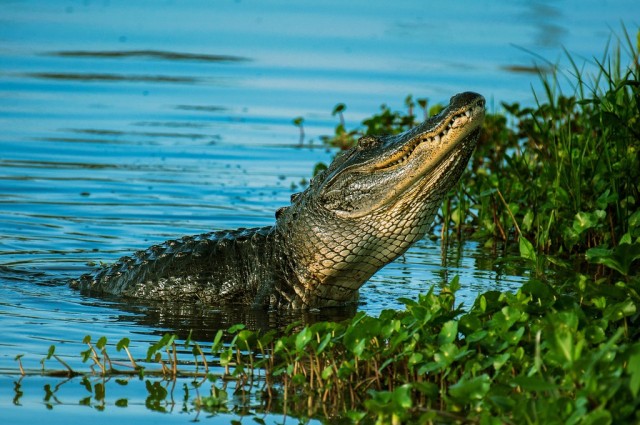by Shelby Wyzykowski
Just once every year, an eggs-tra special day rolls around when a certain long-eared, fluffy-tailed fellow comes hopping down the bunny trail to your home. He brings with him all of the egg-ceptionally tasty springtime goodies that he knows will satisfy your sweet tooth. Your basket gets filled to the brim with chocolate rabbits, pastel-colored confections, and chick-shaped marshmallows, just to name a few delectable treats. It’s a holiday candy lover’s dream! But then you may just notice one thing that’s missing…where are all the eggs? No, the Easter Bunny didn’t forget them. He’s giving you a bit of a challenge this year. He’s remembered an old German tradition that started hundreds of years ago. It was so long ago that he had a different name…Osterhase! Osterhase would secretly lay eggs in the back garden so children could enjoy the outdoors and hunt for their Easter eggs. So, like long ago, you get to look outside (virtually) for eggs too! But as you search and discover egg after egg, little do you know that, beyond your garden, there are many more eggs concealed in secret spots. In fact, they’re all over the world…in mountain forests, on ocean shores, and in steamy swamps. But they’re not hidden by the Easter Bunny. All sorts of animals hide their eggs too! Let’s take some time to eggs-plore the planet and learn more about these eggs-traordinary creatures. Let’s go on an egg hunt!
First let’s search out West for the eggs of a plump, short-tailed bird called the American Dipper. They love to live in and around pristine mountain streams ranging from way up in Alaska and all the way down into Panama! That’s a lot of places for them to hide their eggs, so, for now, let’s just focus on one of the Dipper’s favorite spots in Montana’s Rocky Mountains. Dippers are the only songbirds in the United States that love to routinely swim. And they have several adaptations that make dunking and diving quite easy for them. At the base of their tails, they have what is called a uropygial (oil) gland. They use their beak to collect oil from this gland and, when they preen, it makes their feathers waterproof. They also have nictitating membranes (extra eyelids) and flaps of skin covering their nostrils that protect their eyes and beak when they’re submerged.
But all these swim-friendly features can also help immensely when Dippers nest. To keep their eggs safe from predators, they sometimes build their nests in hard-to-reach spots like cliff ledges, on boulders, and under bridges. But there is one very special, watery way that Dippers like to raise their chicks…behind waterfalls! It can get wet if you live behind a waterfall, so a Dipper nest is specially designed to withstand such damp conditions. The dome-shaped nest is about the size of a soccer ball and has multiple layers of moss, bark, leaves, and coarse grass. The thick, outside shell of moss absorbs moisture so the inside, lined with grass, stays cozy and dry. After around two weeks of incubation, the clutch of four to five eggs hatch. Mom spends a lot of time on the nest, but both parents feed the sparsely-downed chicks up to twenty times an hour! They must fly back and forth through the veil of falling water to get to and from their hungry babies.
After a little over three weeks, the fledgling Dippers are old enough to leave the nest. So, they must bravely make their first trip through the curtain of cascading water. Then they watch and learn from their parents how to wade, swim, and dive in the stream to hunt for food. Sadly, the Dipper’s preferred meals (crayfish, tadpoles, fish eggs, and aquatic insects) become scarce when streams are tainted by humans. Poor practices in logging, mining, and farming can cause these birds to abandon polluted areas. Luckily, for now, they do manage to find new locations with clean, cold, rushing water that they can happily call home.
Now let’s travel a few states over to Florida, one of several Southern states where the American Alligator glides through the waters of slow-moving rivers, lakes, and sweltering marshes. In June and July, the female alligator creates a huge nest out of mud, plants, and sticks. It can be up to two to three feet high and as wide as seven to ten feet! The nest needs to be this big because the mother alligator lays as many as thirty-five to ninety eggs. Once the nest is filled with eggs, she completely covers them up with more vegetation. As the eggs rest hidden and undisturbed for several weeks, an interesting process occurs within the massive mound.

Alligator embryos do not have chromosomes that determine gender, so the temperature of the nest determines how many of the young are girls and how many are boys. If, for example, the nest is located on a sunny riverbank (somewhere around 91 to 93 degrees Fahrenheit), the offspring are mostly male. The temperature of a nest in a cool, shady spot might hover around 86 degrees, and that environment produces mostly females. Around the end of August, the baby gators, still safe in their eggs, start making high-pitched noises. This lets their mom know that they’re ready to break out. She uncovers the nest for them to hatch. When the hatchlings are tiny, they hang out in a small group called a “pod”, but mom is always close by keeping a watchful eye on them. Unfortunately, climate change is beginning to affect the behavior of temperature-dependent species like the alligator. They are beginning to nest earlier and earlier in the year to preserve the correct male to female ratio. The alligators instinctively know that they need to keep a gender balance to allow their species to successfully thrive!
Our last stop covers a wide area, so get ready for the toughest challenge of our hunt! We’re going to search for the eggs of the Loggerhead Turtle. They like to swim in the Atlantic, Pacific, and Indian Oceans, and the Mediterranean Sea. But between late April and early September, the females leave their aquatic homes to nest on the beaches where they themselves hatched decades earlier. Safely under the cover of darkness, a female Loggerhead will use her powerful rear flippers to dig a hole in the sand. After she lays around one hundred eggs, she once again uses her flippers to expertly cover up her eggs. She does such a thorough job that she erases any sign of her nest…it’s a safe and cozy hiding place for her eggs! They need to be well-hidden because the mother Loggerhead does not watch over her nest. Instead, she returns to the sea, leaving the concealed eggs to develop on their own.
Like alligators, the gender of sea turtle embryos is temperature dependent. A nest in warmer sand produces more females (this biological fact concerns marine scientists because global warming will disrupt the proper male to female ratio). After about two months of incubation, the baby turtles hatch and wait for nightfall. Then in a joint effort, they all climb out of the nest together and make a mad dash for the ocean waves. But their journey is fraught with danger.
Predators such as birds, crabs, dogs, and even raccoons are anxiously waiting to make these little turtles into scrumptious evening snacks. And the hatchlings have another, more insidious hazard to deal with…artificial light. To reach the ocean, the hatchlings use the natural light (the moon and stars) horizon to guide them. But beachfront lighting, highway lights, and campfires can disorient them and lead them in the wrong direction. It’s true that the odds are stacked against them, and even though it’s a treacherous trek to the water’s edge, many do make it. And then the real adventure begins for these little ones in their new ocean home!
Now that we’ve finished our egg hunting eggs-pedition, and you’ve fervently feasted on your Easter treats, your once-filled basket contains only some crumpled foil, a clump of Easter grass, and one squashed jelly bean. And, unfortunately, the only thing that you’ve got plenty of are the pangs of an eggs-cruciating stomachache. But while you’re laying back in your favorite comfy chair recovering from the day’s egg-citement, think about all those creatures out there in the world that work so hard to hide their eggs in the most interesting of places. And that leads you to wondering that maybe, just maybe, there might be one more egg still hidden in your garden. It might be hiding behind the daffodils or under the old wheelbarrow or in the tulip bed. And when you feel better, and you go back outside and find that last egg, it seems to me that would be an egg-cellent way to end an eggs-tra special day.

Shelby Wyzykowski is a Gallery Experience Presenter in CMNH’s Life Long Learning Department. Museum staff, volunteers, and interns are encouraged to blog about their unique experiences and knowledge gained from working at the museum.
Related Content
Carnegie Museum of Natural History Blog Citation Information
Blog author: Wyzykowski, ShelbyPublication date: March 29, 2021
